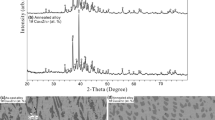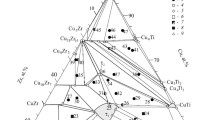Abstract
For the first time, the electrical resistivity of liquid Cu64.5Zr35.5, Cu50Zr50, and Cu33.3Zr66.7 alloys at temperatures up to 1600 K has been measured by the contactless method in a rotating magnetic field. The measurements were taken during cooling in a helium atmosphere with a purity of 99.995%. The error of the electrical resistivity determination did not exceed 5%. It has been found that the electrical resistivity of liquid Cu64.5Zr35.5, Cu50Zr50, and Cu33.3Zr66.7 alloys decreases linearly with increasing temperature, while it increases with temperature for liquid copper and zirconium. The concentration dependences of the electrical resistivity and its temperature coefficient have a maximum at 55 at % and a minimum at about 60 at % Zr, respectively. These concentration dependences are similar to the dependences obtained for amorphous alloys and are explained in the framework of the Ziman theory.
Similar content being viewed by others
Avoid common mistakes on your manuscript.
The Cu–Zr system is among a few binary metallic systems in which bulk amorphous samples have been obtained. It has been demonstrated that amorphous films in the Cu–Zr system can be produced in a wide range of compositions (30–70 at % Zr) [1], whereas bulk amorphous ingots up to 2 mm in diameter can be obtained in only narrow concentration ranges (near 36 and 50 at % Zr) [2].
For elucidating the nature of amorphization, it is necessary to study the physicochemical properties of alloys in this system not only in amorphous, but also in liquid and crystalline states. The thermophysical and electrical properties of the crystalline Cu–Zr alloys have been measured [3–5]. In the liquid state, the thermophysical properties of Cu–Zr alloys have been almost unexplored. This is primarily due to the complexity of the high-temperature experiment, especially with zirconium alloys with high chemical activity and aggressiveness. It should be noted that a few studies of the melts of this system [5] were carried out mainly by the levitation method in the pulsed mode. In this case, the dynamically obtained experimental data are far from equilibrium values, which is completely unacceptable for systems with large relaxation times, such as these glass-forming alloys.
In the present study, we measured, for the first time, the electrical resistivity of the Cu64.5Zr35.5, Cu50Zr50, and Cu33.3Zr66.7 alloys in the liquid state. The selection of compositions is first of all caused by that the first two have the highest amorphization ability, and the last two correspond to the compositions of intermetallic compounds.
Samples were synthesized by arc melting of a mixture of pure zirconium (99.95%) and copper (99.99%) in an argon atmosphere. They were remelted several times to reduce their composition heterogeneity.
The electrical resistivity was measured by the rotating magnetic field method on an original setup. The angle of rotation of the sample φ in a rotating magnetic field depends on its electrical resistance, size, the field strength and frequency, and the elasticity coefficient of a wire. In the relative variant of the method, the electrical resistivity ρ was calculated by the formula:
where I is the current in the stator coil creating a rotating magnetic field, and V is the sample volume. The subscript “zero” refers to the reference sample (tungsten). The measurements were carried out in zirconia crucibles in an atmosphere of helium (purity of 99.995 vol %). The error of determination of electrical resistance of liquid alloys does not exceed 5%. The measurements were carried out during cooling from 1600 K to the alloy crystallization temperature at a rate of 5 K/min. To calculate V in Eq. (1), data on the density of Cu–Zr melts were used [6].
Figure 1 shows the temperature dependences of electrical resistivity ρ(T) of Cu64.5Zr35.5, Cu50Zr50, and Cu33.3Zr66.7 melts. As is seen, the electrical resistance of these melts linearly decreases with increasing temperature. Conversely, in liquid copper [7] and zirconium [8], like in other normal liquid metals, electrical resistance increases with temperature.
The concentration dependences of electrical resistance ρ(x) of the melts and temperature resistance coefficient (TRC) have a maximum at 55 at % and a minimum at about 60 at % Zr, respectively (Fig. 2). For comparison, Fig. 2 shows the concentration dependences of electrical resistance and TRC of amorphous Cu–Zr alloys at 290 K [9]. It follows from Fig. 2 that the concentration dependences of electrical resistance and TRC in the liquid state are analogous to the dependences obtained for amorphous alloys. The ρ(x) maximum in the liquid state as compared with the amorphous alloy is 16% higher and is displaced by 15 at % to a zirconium-rich region. The positions of the minima on the concentration dependence of TRC in both states coincide, but in the liquid state, the TRC magnitude is approximately three times higher than in the amorphous state.
The concentration dependences of electrical resistance and TRC of liquid (or amorphous) alloys can be explained in the framework of the Ziman theory [10]. For liquid and amorphous metal alloys based on transition metals, the d-phase shifts near the Fermi level of a transition metal account for the largest contribution to the electrical resistance. Therefore, three partial structure factors can be replaced by one partial structure factor for a transition metal, and the resistivity can be described by the equation [11]
where Γ and Ed are the d-state scattering resonance width and energy, EF is the Fermi energy, and kF is the Fermi wave vector calculated by the equation
where NA is the Avogadro number, d is the density of an alloy, \(\bar {A} = {{x}_{1}}{{A}_{1}} + {{x}_{2}}{{A}_{2}}\), \(\bar {Z} = {{x}_{1}}{{Z}_{1}} + {{x}_{2}}{{Z}_{2}}\), xi, Ai, and Zi are the concentration, atomic mass, and effective valence of the ith component in the alloy. It follows from Eq. (2) that the electrical resistance of liquid (or amorphous) alloys based on transition metals is dominated by two contributions depending on the resonance scattering and the partial structure factor on the Fermi surface S(2kF). As compared with the structure factor, the resonance contribution slightly changes with temperature and composition, and it can be neglected in analysis of the temperature and concentration dependences of electrical resistivity.
According to the Ziman theory [10], the electrical resistance and its temperature coefficient for liquid and amorphous alloys depend on the 2kF position with respect to the position of the first peak of the structure factor Kp. For calculation of kF, we used the data on the density of liquid [6] and amorphous [12] Cu–Zr alloys. The effective valence of copper and zirconium was taken to be, respectively, 1 and 2, as in [13]. The Kp values for liquid and amorphous Cu–Zr alloys were taken from [14]. The concentration dependences of kF and Kp for liquid and amorphous Cu–Zr alloys are shown in Fig. 3. It is seen that the intersection point of 2kF and Kp in both the liquid and amorphous states corresponds to the composition with 45 at % Zr. This point is consistent well with the position of the maximum on the concentration dependence of electrical resistance of liquid and amorphous Cu–Zr alloys. Specific behavior of the electrical resistivity and TRC is clearly shown in Fig. 4. According to this figure, at constant temperature, the increase in the electron concentration caused by the addition of zirconium with the higher valence leads to the rapid increase in kF and in the electrical resistance to the maximal value at 2kF ≈ Kp; when 2kF > Kp, ρ decreases.
With increasing temperature, the height of the first peak decreases, and its width increases (Fig. 4). Therefore, in the alloys for which 2kF ≈ Kp, the S(2kF) value decreases with increasing temperature, and the TRC becomes negative. In alloys rich in copper or zirconium, S(2kF) increases with temperature, and TRC is positive.
At 2kF ≈ Kp, the TRC can be expressed through the temperature dependence of the first peak of the structure factor:
Equation (4) allows us to explain the threefold excess of the TRC of the liquid Cu–Zr alloys over the TRC of the amorphous alloys. According to X-ray diffraction studies [15], the dS(Kp)/dT value for the Cu50Zr50 alloy is –6.8 × 10−4 K−1 in the liquid and –2.3 × 10−4 K−1 in the amorphous states; i.e., dS(Kp)/dT in the liquid state is three times higher than in the amourphous state.
Thus, it has been shown that the electrical resistance of liquid Cu64.5Zr35.5, Cu50Zr50, and Cu33.3Zr66.7 alloys linearly decreases with increasing temperature, whereas in the liquid copper and zirconium, it increases with temperature. The concentration dependences of the electrical resistivity and its temperature coefficient have a maximum at 55 at % and a minimum at about 60 at % Zr, respectively. The resulting concentration dependences of electrical resistivity and its temperature coefficient for Cu–Zr melts are analogous to the dependence obtained for the amorphous alloys. The position of these extreme points and negative TRC values for the liquid (or amorphous) Cu–Zr alloys are determined by the condition 2kF = Kp.
REFERENCES
Inoue, A., Masumoto, T., and Yano, N., J. Mater. Sci., 1984, vol. 19, pp. 3786–3795.
Kwon, O.J., Kim, Y.C., Kim, K.B., Lee, Y.K., and Fleury, E., Met. Mater. Int., 2006, vol. 12, pp. 207–212.
Gantmakher, V.F. and Kulesko, G.I., Solid State Commun., 1985, vol. 53, pp. 267–268.
Bykov, V.A., Kulikova, T.V., Yagodin, D.A., Filippov, V.V., and Shunyaev, K.Yu., Phys. Met. Metallogr., 2015, vol. 116, pp. 1067–1072.
Fan, G.J., Freels, M., Choo, H., Liaw, P.K., Li, J.J.Z., Rhim, Won-Kyu., Johnson, W.L., Yu, P., and Wang, W.H., Appl. Phys. Lett., 2006, vol. 89, pp. 241917/1–241917/3.
Gangopadhyay, A.K., Blodgett, M.E., Johnson, M.L., McKnight, J., Wessels, V., Vogt, A.J., Mauro, N.A., Bendert, J.C., Soklaski, R., Yang, L., and Kelton, K.F., J. Chem. Phys., 2014, vol. 140, p. 044505.
Matula, R.A., J. Phys. Chem. Ref. Data, 1979, vol. 8, pp. 1147–1298.
Korobenko, V.N. and Savvatimskii, A.I., High Temp., 2001, vol. 39, pp. 525–531.
Pavuna, D., J. Non-Cryst. Solids, 1984, vol. 61/62, pp. 1353–1358.
Ziman J.M., Principles of the Theory of Solids, Cambridge Univ. Press, 1972. Translated under the title Printsipy teorii tverdogo tela, Moscow: Mir, 1974.
Chen, H.S., Rep. Prog. Phys., 1980, vol. 43, pp. 353–432.
Mattern, N., Schops, A., Kuhn, U., Acker, J., Khvostikova, O., and Eckert, J., J. Non-Cryst. Solids, 2008, vol. 354, pp. 1054–1060.
Waseda, Y. and Chen, H.S., Phys. Stat. Solidi B, 1978, vol. 87, pp. 777–782.
Mendelev, M.I., Kramer, M.J., Ott, R.T., Sordelet, D.J., Besser, M.F., Kreyssig, A., Goldman, A.I., Wessels, V., Sahu, K.K., Kelton, K.F., Hyers, R.W., Canepari, S., and Rogers, J.R., Philos. Mag., 2010, vol. 90, pp. 3795–3815.
Mauro, N.A., Vogt, A.J., Johnson, M.L., Bendert, J.C., and Kelton, K.F., Appl. Phys. Lett., 2013, vol. 103, p. 021904/1—021904/4.
ACKNOWLEDGMENTS
This work was supported by the Russian Science Foundation (project no. 14–13–00676).
Author information
Authors and Affiliations
Corresponding author
Additional information
Translated by G. Kirakosyan
Rights and permissions
About this article
Cite this article
Filippov, V.V., Yagodin, D.A., Shunyaev, K.Y. et al. Electrical Resistivity of Cu–Zr Melts. Dokl Phys Chem 483, 155–158 (2018). https://doi.org/10.1134/S0012501618120035
Received:
Published:
Issue Date:
DOI: https://doi.org/10.1134/S0012501618120035








